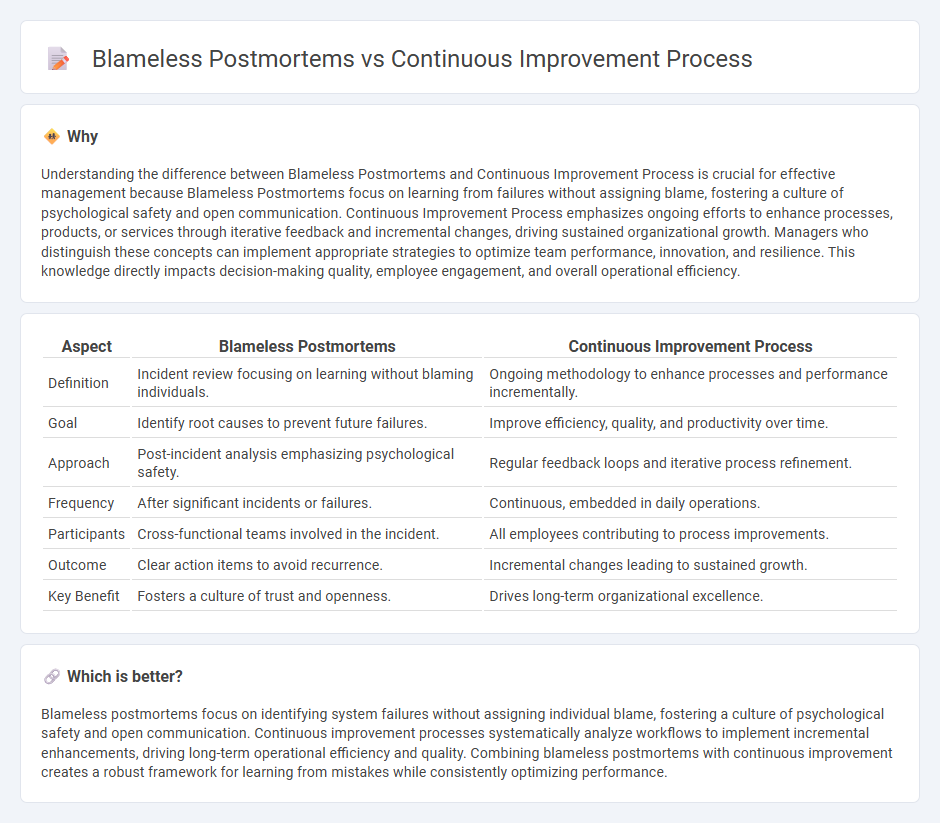
Blameless postmortems foster a culture of accountability by analyzing failures without assigning personal blame, encouraging transparent communication and learning. Continuous improvement processes systematically enhance workflows through iterative feedback and data-driven adjustments across teams. Explore how integrating blameless postmortems can amplify the effectiveness of your continuous improvement initiatives.
Why it is important
Understanding the difference between Blameless Postmortems and Continuous Improvement Process is crucial for effective management because Blameless Postmortems focus on learning from failures without assigning blame, fostering a culture of psychological safety and open communication. Continuous Improvement Process emphasizes ongoing efforts to enhance processes, products, or services through iterative feedback and incremental changes, driving sustained organizational growth. Managers who distinguish these concepts can implement appropriate strategies to optimize team performance, innovation, and resilience. This knowledge directly impacts decision-making quality, employee engagement, and overall operational efficiency.
Comparison Table
| Aspect | Blameless Postmortems | Continuous Improvement Process |
|---|---|---|
| Definition | Incident review focusing on learning without blaming individuals. | Ongoing methodology to enhance processes and performance incrementally. |
| Goal | Identify root causes to prevent future failures. | Improve efficiency, quality, and productivity over time. |
| Approach | Post-incident analysis emphasizing psychological safety. | Regular feedback loops and iterative process refinement. |
| Frequency | After significant incidents or failures. | Continuous, embedded in daily operations. |
| Participants | Cross-functional teams involved in the incident. | All employees contributing to process improvements. |
| Outcome | Clear action items to avoid recurrence. | Incremental changes leading to sustained growth. |
| Key Benefit | Fosters a culture of trust and openness. | Drives long-term organizational excellence. |
Which is better?
Blameless postmortems focus on identifying system failures without assigning individual blame, fostering a culture of psychological safety and open communication. Continuous improvement processes systematically analyze workflows to implement incremental enhancements, driving long-term operational efficiency and quality. Combining blameless postmortems with continuous improvement creates a robust framework for learning from mistakes while consistently optimizing performance.
Connection
Blameless postmortems foster a culture of transparency and learning by focusing on systemic issues rather than individual faults, which directly supports a continuous improvement process aimed at enhancing organizational performance. This approach enables teams to identify root causes of failures and implement actionable changes without fear of retribution, accelerating iterative development and optimization. Integrating blameless postmortems into continuous improvement cycles ensures sustained growth and resilience by systematically refining practices based on empirical insights.
Key Terms
**Continuous improvement process:**
The continuous improvement process emphasizes systematic evaluation and incremental enhancements to workflows, aiming for sustained operational excellence and efficiency in organizations. It leverages data-driven insights, employee feedback, and iterative adjustments to optimize performance over time. Explore how integrating continuous improvement principles can transform your business outcomes.
Kaizen
The continuous improvement process embodies the Kaizen philosophy by fostering ongoing, incremental enhancements across all organizational levels, emphasizing employee involvement and proactive problem-solving. Blameless postmortems complement this approach by creating a psychologically safe environment where teams analyze failures without assigning blame, thus facilitating honest learning and rapid iteration. Explore how integrating Kaizen practices with blameless postmortems can transform your operational efficiency and team dynamics.
Feedback loops
Continuous improvement processes emphasize iterative feedback loops to refine workflows and increase efficiency by systematically identifying and addressing defects or inefficiencies. Blameless postmortems foster open communication and learning from failures by removing personal blame and focusing on system-level causes, thereby enhancing the quality and reliability of outcomes. Explore how integrating these methodologies can transform organizational learning and operational resilience.
Source and External Links
Continual improvement process - Wikipedia - A continuous improvement process (CIP) is an ongoing effort to improve products, services, or processes, focusing on incremental or breakthrough changes by continually evaluating efficiency, effectiveness, and flexibility with feedback as a core principle.
Continuous Process Improvement (CPI): A Guide for Businesses - Continuous Process Improvement is a gradual, iterative approach to enhance workflows, relying on small incremental changes, employee involvement, and repeating improvement cycles to adapt and optimize processes over time.
Continuous Improvement Model - ASQ - Continuous improvement uses methodologies such as the PDCA cycle, Six Sigma, and Lean to achieve ongoing product and service quality improvements through incremental and breakthrough efforts with a focus on measurement, assessment, and employee teamwork.
 dowidth.com
dowidth.com